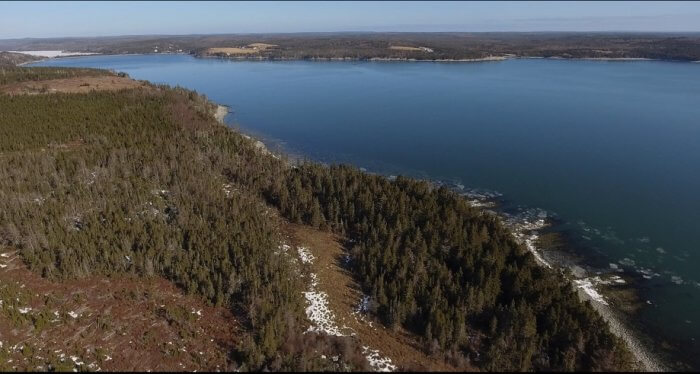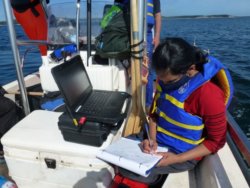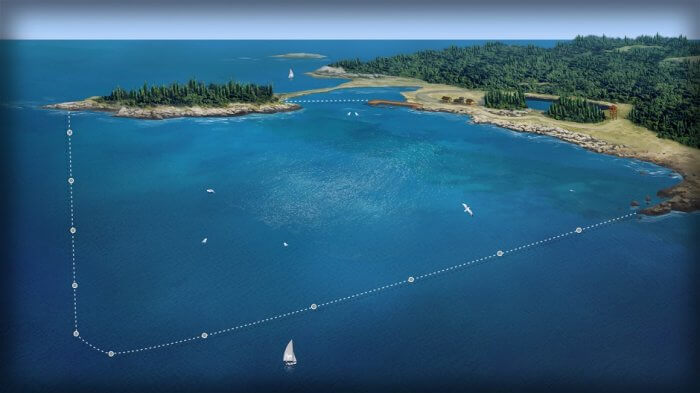How we selected Port Hilford, Nova Scotia, as the ideal location for a gold-standard sanctuary for whales being retired from marine entertainment parks and aquariums.
In our search, on the east and west coasts of the United States and Canada, we were guided by three main considerations:
Physical criteria: These included basic oceanographic and hydrologic analyses of depth, sea-floor conditions, tides and currents, run-off and pollution, flora and fauna, as well as where and how to build the nets, and access to fresh water and electric power.
Impacts on wildlife: In addition to being concerned about how sanctuary residents might be affected by local wildlife, we also had to evaluate potential impacts they may have on free-ranging animals outside of the sanctuary. This was particularly sensitive in areas that are critical habitat for endangered populations like the Southern Resident orcas in the Northwest and North Atlantic right whales in the Northeast.
Community interests: Equally important are the concerns of the local community: commercial and recreational fishing interests, access for boats, population density along the shoreline and other “stakeholder interests.” We understood that when a local community embraces the idea of having a whale sanctuary and sees it as a long-term benefit to all that they hold dear for their community, then we would have a partnership that will lead to successfully creating a home for captive orcas and belugas.
Our basic specs for the sanctuary included:
- 100 acres of water
- Sufficient depth for the whales to dive and explore
- Protection from extreme weather
- Free of sewage, pollutants and noise
- Good flushing rate
- Ability to create separate areas for medical and management
- Not a lot of human activity or boat traffic.
The first stage of the site search involved using nautical charts, computer maps and recommendations from residents. We researched more than 130 possible sanctuary locations in Washington State, British Columbia and Nova Scotia.
In British Columbia, we researched hundreds of locations that would be ideal for orcas, and we visited dozens of them around Vancouver Island. Most, however, were too far from human civilization – fresh water, power, transport, schools, medical facilities – to be practical.
In Washington State, the San Juan Islands, by comparison, were within easy reach of a major metropolitan area. But most of the sites that would be good for whales were also close to people with homes and businesses nearby.
In Nova Scotia, however, we found the perfect combination. Several small communities stepped forward not only to offer their help in finding a suitable location, but to engage with us as potential partners in the creation of a whale sanctuary. And early in 2020, we selected one location as having clearly met all of our criteria.
(There’s more detail about the site search in this series of blog posts.)
Selection of Port Hilford, Nova Scotia, for the sanctuary

On February 26th 2020, we announced our choice of Port Hilford Bay in Nova Scotia as the premier location for a sanctuary for whales coming from marine parks and aquariums.
Port Hilford fulfilled all three of our principal considerations: It offered an expansive area that can be netted off for the whales in a bay that’s open to the ocean but was sheltered from storms. It had access to necessary infrastructure and plenty of room along the shore for the facilities that would be needed to care for the animals. And we couldn’t have asked for a more welcoming and eager community than the people of the Sherbrooke area.
Site Development Work

We then embarked on a year of site development work in order to decide on the specific placement of the sanctuary within this large bay. To ensure that the sanctuary could provide the quality of life that the whales deserve, we needed to know as much as possible about the bay, the freshwater inlets and ponds nearby, and of the lands surrounding the bay. The results of the data analyses would also be included in our permitting submissions and would inform our engineering studies for the actual construction of the sanctuary. Some of the things we needed to understand were:
- the ranges of water temperature;
- whether there is runoff from the shore during storms and if it contains any detrimental pollution;
- details about currents, tides and wave action and how these change during storms;
- whether there are any underwater sounds that might disturb or alter whale behavior;
- and what other kinds of animals live in and around the bay.
(For a deep dive into the environmental analysis, check out this blog post.)
Selecting the boundaries of the sanctuary
The site development phase was challenged by the COVID-19 pandemic and the closing of the border between Canada and the United States, and even between Nova Scotia and the rest of Canada. But with lots of teleconferencing, along with help and support from the local community, we were able to press ahead.
And in March 2021, we were delighted to announce that the sanctuary would be located in over 100 acres of ocean around the wharf near the mouth of Port Hilford Bay the wharf and around Barachois Island to Rocky Point.

Being able to set the precise position and boundaries of the sanctuary was a key milestone, leading to submissions to government agencies for the lease and any necessary permits. It also enabled us to plan the perimeter nets and the preliminary designs and layouts for sanctuary buildings. For samples of these, go here.
More about the sanctuary:
The Sanctuary – an Introduction
Read more about this unique project to give them a new life that makes up for what went before.
FAQ About the Sanctuary
Take a Tour of the Sanctuary Site
Sanctuary Perimeter Net and Building Designs
Check out these hi-tech sanctuary nets and sample floor plans.
And some articles from the "Deeper Dive" Section
Benefits of a Seaside Sanctuary
Caring for Orcas at a Sanctuary
How Whales and Dolphins Fare in Captivity
The Sanctuary – an Introduction
A new life that makes up for what went before, Read more about it.